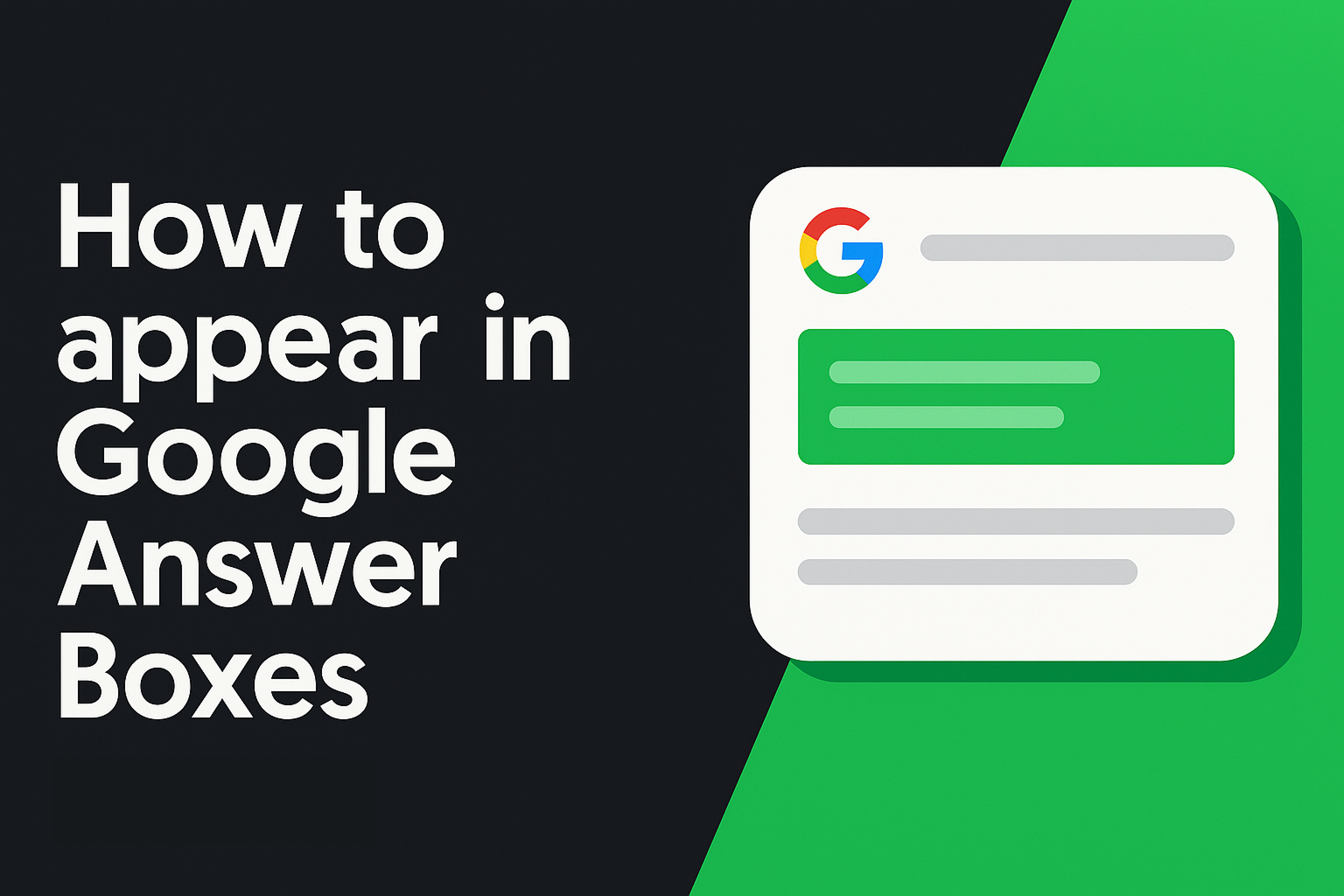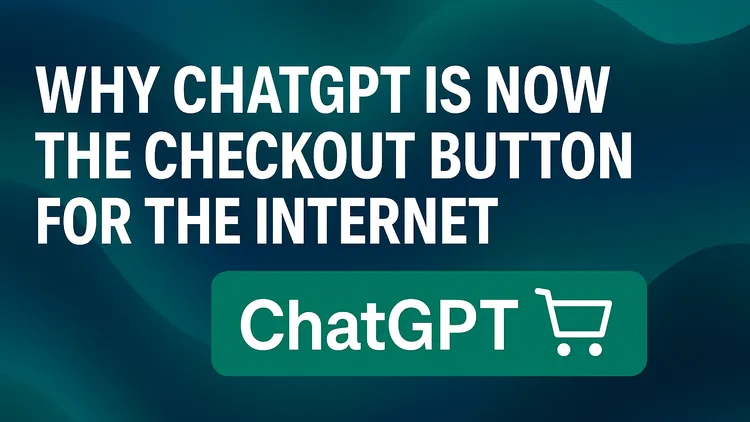
How to appear in the Google Answers Box (Featured Snippets)
Getting your content into Google’s Answers Box, also known as featured snippets, can change how much visibility your site receives. This is the piece of text that appears above the regular search results and directly answers the user’s query. When your page is pulled into this slot, it earns prime real estate in search and attracts attention from users before they even glance at other results.
If you want to appear in the Google Answers Box, you need to structure your content so it’s concise, authoritative, and easy for Google to extract. Featured snippets reward content that answers questions directly, uses clear formatting, and demonstrates credibility. By focusing on intent, organizing your writing into scannable sections, and signalling relevance through headings and markup, you position your pages to win that highly visible box at the top of search.
So how do I get featured? (Instructions at a glance)
- Featured snippets appear because Google identifies your content as the clearest answer to a query.
- Structuring content with concise definitions, lists, and tables helps search engines extract it.
- Answer the primary question early in your content to increase snippet potential.
- Use headers, schema, and formatting to highlight the structure of your information.
- Build authority with clear language, reliable sources, and consistent topical depth.
- Track performance using analytics tools to see which pages win snippets and refine them further.
- Consider how different snippet types (paragraph, list, table, video) affect formatting strategy.
Table of Contents
- So how do I get featured? (Instructions at a glance)
- Understanding the Google Answers Box
- How Google Selects Featured Snippets
- Structuring Content for Snippet Success
- Crafting Precise and Authoritative Answers
- Optimizing for Different Snippet Types
- Measuring and Tracking Featured Snippets
- Evolving with Google’s Changes
- FAQs
- Conclusion
Understanding the Google Answers Box
Featured snippets sit at the very top of search results and are designed to give users quick responses. They are pulled directly from a webpage when Google detects content that addresses the query clearly. According to Google’s own documentation, these snippets are chosen automatically, and site owners cannot apply for them in a direct way. This makes content structure and clarity critical.
For many businesses, this placement is often called “Position Zero” because it outshines the traditional first result. Studies shared by Backlinko highlight how gaining this slot can increase click-through rates significantly. By aligning your writing with how search engines interpret relevance, you can put your pages in contention for this premium space.
What is a Featured Snippet
A featured snippet is not just an excerpt. It’s a carefully extracted piece of text, often accompanied by a list, table, or video thumbnail, that Google sees as the clearest answer to a user’s question. AmericanEagle.com explains that snippets come in several formats, with paragraphs, lists, and tables being the most common. Each is presented differently but follows the same principle of answering fast.
For readers, snippets reduce friction. For site owners, they offer a unique chance to capture visibility even without holding the top ranking. This happens because the box is designed to summarize, not replace, deeper reading. A concise definition or clear breakdown is often enough for Google to highlight your page over others.
Why It Matters for Visibility
Appearing in a featured snippet provides more than prestige. It directly impacts user behaviour. Research from Niumatrix notes that click-through rates can shift dramatically once a site secures this placement, sometimes doubling or tripling traffic for certain queries. For local New Zealand businesses, that advantage can reshape their market share online.
There’s also a voice search angle. Snippets frequently power the responses given by Google Assistant and other voice-driven tools. This extends visibility beyond the page and into spoken answers, which can spread your content’s reach in entirely new contexts. Winning that spot is not just about more clicks but about becoming the default response in a wide range of search environments (Google, ChatGPT, Siri, and more).
How Google Selects Featured Snippets
Google does not handpick snippets. Its systems automatically determine which pages provide the clearest, most helpful response. According to Google’s official explanation, the box is designed to summarize information and guide users toward deeper reading. This means Google prioritizes clarity, formatting, and relevance, not brand size or marketing budgets.
For local New Zealand businesses, this creates an opportunity. Even a small operator in Wellington or Christchurch can compete with global brands if their content is structured in a way that satisfies the query better.
The Role of Search Intent
Google’s ranking systems revolve around interpreting the user’s need. The Search Central overview outlines how signals like keyword context, freshness, and page usability shape what is displayed. In snippet selection, intent alignment becomes even more critical. If someone types “best time to plant feijoas in Auckland,” Google looks for content that directly answers the seasonal question rather than giving a generic gardening guide.
Local New Zealand businesses often win here because they can tailor answers to regional specifics. A Hamilton nursery that publishes a concise explanation of planting conditions for Waikato soil has a better chance of being pulled into the box than an international gardening site with only broad advice.
Content Signals Google Recognizes
Content that gets extracted into snippets typically shows a few common traits. Research from Moz highlights that Google leans toward pages where the answer is short, positioned near the top, and reinforced with clear formatting like lists or tables. Consistency in headers also helps because it signals scannability.
Beyond structure, authority matters. When Google detects expertise, trustworthiness, and topical focus, it has greater confidence in elevating that page. A study by Ahrefs examined millions of keywords and found snippets often come from pages already ranking in the top five results. So even if a local Wellington café writes the perfect definition of “flat white,” they are unlikely to appear unless they already rank for that term in some capacity.
The Impact of Query Types
Not all searches generate snippets. Queries that ask clear questions, compare products, or seek definitions are more likely to trigger them. The Ahrefs analysis revealed that informational and how-to searches dominate snippet appearances. Commercial or transactional queries, like “buy sports shoes online in NZ,” rarely get a snippet box because intent is purchase-driven.
Data from SparkToro’s zero-click study also shows that snippets often lead to fewer clicks on traditional results but greater exposure for the chosen site. For local New Zealand businesses, that trade-off can still be valuable. If a Dunedin plumber provides a direct answer to “how to fix low water pressure,” their brand gets visibility even if the user does not immediately click through.
Structuring Content for Snippet Success
Google prefers information it can easily extract. That means your content must be arranged in a way that both humans and algorithms can scan quickly. A guide from MA Accelerator stresses that structure is just as important as the words you choose. By giving your answers shape, you give search engines confidence in presenting them.
For local New Zealand businesses, the advantage often lies in using straightforward structures. A florist in Tauranga describing seasonal flowers with clear lists and short explanations has a higher chance of being surfaced than a long, unbroken page of text.
Using Clear Headings
Headings signal order. They break up content into pieces that are easy to follow. According to PhotoBiz, aligning headings with likely search questions increases the chances that Google recognizes your section as the answer. A simple H2 stating “How to prune roses in spring” followed by a clear explanation is stronger than a vague subheading.
Readers benefit from this structure too. Skimmable headings help them find their answer without effort. Google values that efficiency, and so does the person scanning your site before booking your service or making a purchase.
Formatting Answers Directly
Directness helps Google extract meaning. The Advanced Web Ranking guide explains that answers close to the question and written in concise form have the highest chance of appearing in snippets. That means opening a section with a one-sentence response before expanding further.
Imagine a travel agency in Queenstown writing: “The best time to visit Queenstown for skiing is between June and August.” That sentence alone could be lifted into a featured snippet. Additional paragraphs may explain conditions, costs, and off-season benefits, but the snippet-ready answer comes first.
Leveraging Lists and Tables
Lists and tables are particularly snippet-friendly. Sitebulb notes that numbered lists often win for step-by-step queries, while tables dominate in comparisons. Presenting structured data like “home loan rates in New Zealand banks” in a simple table gives Google an easy block to reuse.
Nightwatch also points out that HTML formatting matters. Using actual list and table tags, rather than plain text imitations, makes extraction smoother. A Wellington café comparing coffee brewing methods in a neatly formatted table will often outpace a competitor who only describes them in prose.
Crafting Precise and Authoritative Answers
Winning a featured snippet often comes down to how tightly you frame an answer. Long explanations have their place, but the first sentence or two needs to stand alone. Google explains in its helpful content guidelines that answers must serve readers first and demonstrate reliability. If your content meanders or hides the key point, it rarely earns that spotlight.
For local New Zealand businesses, this clarity can separate them from larger international sites. A direct one-line definition of a term like “What is a flat white” followed by context about New Zealand’s coffee culture provides both precision and depth.
Clarity in Language
Clarity matters more than word count. According to OkWrite, content stands out when it avoids filler and presents terms in their simplest form. A concise explanation satisfies the immediate question, while follow-up paragraphs explore variations or examples.
Think of a tourism site in Rotorua answering “What is a geothermal pool.” Leading with a single, unambiguous sentence makes it snippet-ready. Expanding on temperature ranges, cultural significance, and safety comes afterward. That hierarchy of directness followed by context aligns with how Google evaluates relevance.
Establishing Expertise
Authority builds trust in both readers and search engines. SEO Clarity notes that consistent topical focus and references to credible sources increase the perception of expertise. For a snippet, that trust translates into higher chances of extraction. If Google views your site as a go-to source, your answers carry more weight.
This is particularly valuable for industries that require reliability. A health clinic in Auckland writing about nutrition needs to cite research and maintain a professional tone. By doing so, the clinic signals to both readers and Google that the information is not only precise but also trustworthy.
Optimizing for Different Snippet Types
Not all snippets look the same. Google adapts the box based on what best matches the query. According to SERanking, the most common types are paragraph, list, and table formats, while video snippets are also on the rise. Each requires a slightly different approach in how content is structured.
Local New Zealand businesses that understand these distinctions can shape their content accordingly. A law firm in Wellington answering legal definitions might aim for paragraph snippets, while a gardening shop in Hamilton could format a step-by-step guide for list snippets.
Paragraph Snippets
Paragraph snippets appear when Google wants a short explanation or definition. AmericanEagle.com notes that the sweet spot is often around 40 to 60 words. Opening a section with a sentence that fully answers the question, then elaborating with context, provides the right balance.
Consider an Auckland property management site. If a searcher asks, “What is a body corporate,” the site should lead with a clean, one-sentence definition. Subsequent paragraphs can explain responsibilities, fees, and variations in New Zealand law, but the snippet-ready portion is already there at the top.
List Snippets
Step-by-step processes or itemized breakdowns often generate list snippets. Nightwatch highlights that numbered lists are especially effective when the query implies order. Unordered lists also work, especially for collections like “types of native New Zealand trees.”
Local businesses can make use of this by formatting practical content. A Christchurch café sharing “how to brew pour-over coffee” should format the instructions as a numbered sequence. Each step should be clear enough to stand alone, yet concise enough for Google to lift as a block.
Table Snippets
Tables dominate when comparisons are involved. SERanking explains that Google favours them for data-driven queries like prices, schedules, or specifications. Using proper HTML table formatting ensures Google can detect and extract the structure correctly.
An example might be a Wellington bank creating a simple table of mortgage rates across loan terms. Presenting the data in rows and columns, with clear headings, gives search engines exactly what they need. Readers benefit too, since information becomes easy to scan and compare at a glance.
Video Snippets
Video snippets appear when a query is best answered visually. Nightwatch points out that YouTube is the most common source, with Google often highlighting clips at the exact timestamp where the answer begins. Creating short, focused videos with descriptive titles and transcripts increases the chances of being pulled into this box.
A tourism company in Queenstown might record a quick walkthrough showing “how to bungee jump safely.” By providing captions, timestamps, and a clear structure, they give Google the signals it needs to surface that video directly in response to a search.
Measuring and Tracking Featured Snippets
Winning a snippet is only half the challenge. The other half is understanding how that visibility affects your traffic and adjusting content to maintain the advantage. Featured snippets shift constantly, so regular monitoring is essential. According to AmericanEagle.com, performance measurement often starts with tools like Google Search Console, Ahrefs, or SEMrush, which highlight impressions and ranking changes tied to snippet appearances.
For local New Zealand businesses, knowing which queries bring in snippet traffic helps refine strategy. A travel operator in Rotorua can learn if “best geothermal pools to visit” drives engagement from its featured placement, or if competitors are taking the spotlight.
Using Analytics Tools
Google Search Console remains the most direct tool for spotting featured snippet impressions. DashThis explains how filtering queries lets you see which searches triggered snippet visibility and what the click-through rate looks like. Pairing this with Google Analytics can reveal if the snippet exposure turns into time on site, inquiries, or bookings.
Other platforms offer complementary insights. Hashmeta AI compares a wide range of snippet tracking tools, including SEMrush Position Tracking, Ahrefs, and RankRanger. These platforms allow businesses to monitor not only their own snippets but also competitor wins, providing a fuller picture of shifting SERP dynamics.
Monitoring Competitor Snippets
Tracking is not just about your own performance. Competitor monitoring reveals which content formats or query types they dominate. Gracker.ai suggests using Search Console data alongside third-party tools to map out which snippets drive traffic for your rivals. This information highlights gaps you can target.
OneUpWeb outlines how to combine manual checks with tool-based reporting to see snippet changes over time. For a local Wellington café, noticing that a competitor has secured the “how to make a flat white” snippet could trigger updates to their own barista guide, refining the structure and adding clearer definitions.
Evolving with Google’s Changes
Featured snippets are not static. Google continuously adjusts how it displays information, and content creators need to keep pace. Core updates often reshape rankings, which in turn shifts which pages earn snippets. Google’s guidance on updates emphasizes that broad improvements to content quality are the best safeguard against volatility.
Local New Zealand businesses that rely on organic traffic must stay alert. A site that wins a snippet today might lose it tomorrow if an update favours content with clearer formatting, fresher data, or better alignment with intent.
Adapting to Algorithm Updates
Major updates influence snippet eligibility. The June 2025 core update analysis highlights a stronger emphasis on trust signals and page experience. That means content accuracy, author credibility, and loading speed all play a role in maintaining snippet visibility.
A local accounting firm in Auckland publishing tax guides may notice ranking shifts after such updates. Adjusting for clearer sourcing, stronger author bios, and mobile usability helps protect their placement. Updates are not about penalties so much as changing the standards for what quality looks like.
Future of Snippets in Search
The way snippets appear is changing as Google integrates AI-generated results. Research from GSQi shows how AI Overviews sometimes replace or reduce the visibility of featured snippets. For some queries, the AI summary appears above everything else, reshaping how users interact with the results.
This does not eliminate the value of snippets but places them in a new context. Being featured inside an AI Overview or alongside it can still drive traffic and reinforce authority. Businesses that adapt their content to suit both snippets and AI responses stay competitive as search evolves.
Balancing Snippets with Other SEO Tactics
Snippets remain powerful, but they cannot be the only strategy. Campaign Digital stresses that sustainable visibility comes from a balance of technical SEO, authority-building, and user experience. Pairing snippet-focused content with broader Answer Engine Optimization strategies, explained in Wikipedia’s overview, positions a site for the future of search.
For a Wellington design agency, that balance might include writing concise snippet-ready definitions while also investing in schema markup, backlinks, and social proof. As algorithms and AI-driven features shift, diverse tactics provide resilience.
FAQs
What exactly is a featured snippet in Google search?
A featured snippet is a short block of content that appears above the main search results, summarizing an answer directly from a webpage. According to Google’s documentation, snippets are chosen automatically based on how clearly a page responds to a query.
Do I need to apply to appear in the Google Answers Box?
No. Google states that site owners cannot request snippets directly. Content is selected algorithmically when it matches intent and provides a clean, structured response. Google Search Central confirms that snippets are generated automatically.
How long should my snippet-ready answer be?
Research shared by AmericanEagle.com suggests that paragraph snippets often fall in the range of 40 to 60 words. The key is to lead with a concise definition or statement before expanding with more detail in subsequent paragraphs.
Are all search queries likely to trigger snippets?
Not all searches generate them. Ahrefs found that informational and how-to queries are the most common triggers, while transactional searches rarely produce snippets.
What is the best way to structure my content for snippet eligibility?
Clear headings, direct answers, and use of HTML lists or tables all improve extraction. Guides from Sitebulb and MA Accelerator both emphasize formatting as a major factor.
How can I measure if my page has won a snippet?
Google Search Console is the simplest way to track impressions and clicks from snippets. DashThis explains how filtering queries reveals which searches triggered snippet visibility.
Do snippets impact my overall organic traffic?
Yes. A study from SparkToro shows that snippets can reduce clicks on traditional results but increase visibility for the highlighted site. For many businesses this added exposure is worth it.
Can small local businesses compete for snippets against large international sites?
They can. Moz notes that snippets often come from pages already ranking in the top five results, but smaller, well-structured content that directly serves intent can outrank generic global advice, particularly when queries are region-specific.
How do algorithm updates affect snippet visibility?
Core updates regularly change which pages appear in snippets. The June 2025 update analysis emphasized trust signals, mobile usability, and content clarity. These shifts can cause pages to gain or lose snippet status overnight.
Will AI Overviews replace featured snippets?
AI Overviews are increasingly appearing in place of or alongside snippets. Research from GSQi shows their growing presence, though featured snippets still play a role. The balance between the two will likely evolve as search interfaces change.
Can New Zealand businesses realistically win featured snippets?
Yes. Even small operators can secure snippets if their content is clear and structured. For example, a gardening shop in Hamilton that creates a direct guide on planting feijoas in local conditions may outperform global sites with more generic advice, since Google values context that aligns with the user’s intent.
What type of snippet opportunities exist for New Zealand service industries?
Local industries often succeed with how-to and definition content. A plumbing business in Dunedin answering “how to fix low water pressure in New Zealand homes” or a Wellington café showing “steps to brew a flat white” can provide snippet-ready material. These concise, region-focused responses give search engines exactly what they need.
How can New Zealand tourism companies use snippets to attract visitors?
Tourism businesses can publish concise answers to common travel questions. A Queenstown operator could target queries like “best time to visit Queenstown for skiing” with a short definition at the top of the page, followed by details on conditions and costs. This style of content often fits well into snippet formats.
What kind of snippet content works for New Zealand real estate agencies?
Agencies can write clear, structured definitions for industry terms. An Auckland firm might publish “What is a body corporate in New Zealand” as a standalone heading with a one-sentence answer beneath it. Google favours this format for paragraph snippets, especially when tied to local context.
Can New Zealand e-commerce shops win list or table snippets?
Yes. An online retailer in Wellington selling sports gear could create a comparison table of running shoe sizes or a numbered list showing “steps to choose the right hiking boots.” Google often extracts structured data like this for list or table snippets.
Conclusion
The Google Answers Box represents one of the most visible opportunities in search. It favours content that is clear, authoritative, and structured in a way that machines can easily parse. Throughout this article we have seen how concise explanations, clean formatting, and attention to user intent all work together to shape content that stands a chance of appearing in that top slot.
For local New Zealand businesses, the chance to win a featured snippet is not limited to large international players. By focusing on precision, building authority, and maintaining adaptability to algorithm changes, smaller operators can earn a place at the very top of search results. The significance lies in how these snippets influence not only traffic, but also brand visibility in a landscape that is increasingly shaped by voice assistants and AI-driven overviews.
Snippets are more than a technical feature of search. They reflect the way Google interprets what users value most in an answer. Crafting your content with this in mind allows you to compete where attention is shortest and visibility is greatest. The future of online discovery is shaped by how well information is structured, and the businesses that recognize this will be the ones most often seen, remembered, and trusted. Now is the time to shape your answers with care so they can stand in that spotlight when it matters most.
For featured snippet research and optimization, hire a local SEO expert that will analyze your search presence, identify snippet opportunities, and structure your content to align with how Google surfaces answers.

Mitch John
Mitchell is a digital marketing expert and developer focused on Shopify apps, SEO, AI Search, and e-commerce strategy in New Zealand and beyond. He writes about digital marketing, AI news, business strategy, and his experiences working with over 200 New Zealand businesses on their digital marketing strategies and websites, ranging from small startups to $500m+ companies.


